VOA慢速英语-THIS IS AMERICA - 'New Birth of Freedom' Guides New
搜索关注在线英语听力室公众号:tingroom,领取免费英语资料大礼包。
(单词翻译)
Largest battle ever fought in North America took place in Pennsylvania 145 years ago this week. Transcript1 of radio broadcast:
29 June 2008
Welcome to THIS IS AMERICA in VOA Special English. I'm Steve Ember.
VOICE TWO:
And I'm Barbara Klein. This week on our program, we visit Gettysburg, Pennsylvania. This small town in the Northeast is one of the most important places in American history.
(SOUND)
VOICE ONE:
Much of the area around Gettysburg still looks like it did in the eighteen sixties, during the Civil War. We arrive in the middle of farming country. All around are fields of wheat, corn and other crops. Cows chew on grass under a warm morning sun.
Roads that pass through town lead to Baltimore, Washington and other cities. But one hundred forty-five years ago this week, they served another purpose. They brought two opposing armies to Gettysburg.
VOICE TWO:
One was the United States Army of the Potomac, commanded by General George Gordon Meade. The other was the Confederate Army of Northern Virginia led by General Robert E. Lee.
Lee and his troops had moved north into Pennsylvania from Virginia. There, they had won a series of battles. Now they were on the move to defeat Meade's army.
Lee believed that a Southern victory on Northern soil would force a negotiated2 settlement of the war. This would mean independence for the Confederate states that were attempting to leave the Union.
VOICE ONE:
The battle of Gettysburg began on July first, eighteen sixty-three. More than one hundred seventy thousand soldiers fought for three days. It was the largest battle ever fought in North America.
When it ended on July third, more than fifty thousand soldiers were dead, wounded or missing. Many more would die later from their wounds.
In the end, General Lee's army lost the battle. The Civil War would continue for two more years. But Confederate hopes for independence were never again as high as they had been at Gettysburg.
(MUSIC)
VOICE TWO:
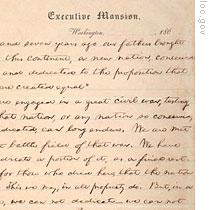 |
| [Detail] President Lincoln's handwritten copy of the Gettysburg Address. The speech is considered one of the most memorable3 in United States history. |
Soon after the great battle, people began to visit Gettysburg to try to understand what happened there. One of those visitors, on November nineteenth, eighteen sixty-three, was President Abraham Lincoln. He was invited to help dedicate4 a cemetery5 for Union soldiers killed in the battle.
Lincoln spoke6 for just two minutes. The speech began this way:
READER: "Four score and seven years ago, our fathers brought forth7 on this continent a new nation, conceived8 in liberty and dedicated9 to the proposition10 that all men are created equal."
VOICE ONE:
President Lincoln had never been satisfied with the reality of American life at that time. The Declaration11 of Independence in seventeen seventy-six had declared all men equal. Yet in the South, and earlier in the North as well, black men and women were held as slaves.
In his address at Gettysburg, Lincoln described a new future for a nation that would be reunited. Our reader is Jim Tedder12.
READER: "It is for us the living, rather, to be dedicated here to the unfinished work which they who fought here have thus far so nobly advanced. It is rather for us to be here dedicated to the great task remaining before us — that for these honored dead we take increased devotion to that cause for which they gave the last full measure of devotion — that we here highly resolve that these dead shall not have died in vain — that this nation, under God, shall have a new birth of freedom -- "
VOICE TWO:
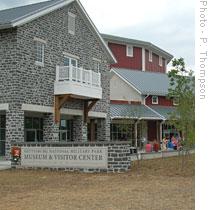 |
| Gettysburg Museum and Visitor Center |
This idea, a new birth of freedom after the Civil War, guides the newly built Gettysburg Museum and Visitor Center. It opened on April fourteenth at Gettysburg National Military Park.
April fourteenth, eighteen sixty-five, was the day Lincoln was shot. He was killed by John Wilkes Booth, an actor from Maryland, just days after a Confederate surrender ended the war.
(MUSIC)
VOICE ONE:
Gettysburg National Military Park was established in eighteen ninety-five, thirty-two years after the battle. Gettysburg is the most visited of the Civil War battlefields. Every year about two million people visit the park from around the country and the world.
Park officials say the new museum will better prepare visitors to see the battlefield through the soldiers' eyes. The battlefield covers more than two thousand four hundred hectares.
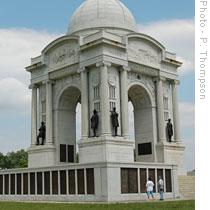 |
| Pennsylvania monument on the battlefield at Gettysburg |
Visitors can find more than one thousand three hundred outdoor sculptures around the battlefield. These are monuments and memorials placed by soldiers' groups and state militias13 in areas where their troops fought.
VOICE TWO:
Volunteer guides explain what happened in each area of the battlefield. A guide at the high ground called "Little Round Top" describes an action involving Union troops led by a general named Daniel Sickles14.
GUIDE: "He sent some Maine infantry15 and some U.S. sharpshooters over there into the trees to the right of that tower. And they were out there looking for troops, for possible threats. They found 'em. They got into a fight with Confederate troops, but not the same ones who were going to be marching down here, not the fourteen thousand under a general named James Longstreet."
VOICE ONE:
One part of the new Gettysburg Museum and Visitor Center will not open to the public until September: a complete cyclorama painting. This kind of artwork surrounds the people looking at it.
The painting shows the final attack in the Battle of Gettysburg: Pickett's Charge. George Pickett was a Confederate general. On July third, eighteen sixty-three, he led a charge against stronger Union forces. It was a disaster for the Confederate soldiers.
The painting is one hundred fourteen meters long. French painter Paul Philippoteaux and a team of twenty artists created it in eighteen eighty-four.
VOICE TWO:
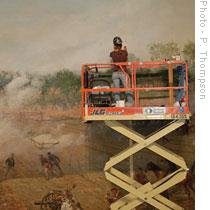 |
| An artist repairs part of the cyclorama at Gettysburg National Military Park |
The cyclorama has always been one of the most popular parts of the Gettysburg experience. But the painting was in bad shape after all these years. So a restoration project began in two thousand three. The painting was cleaned and separated into its fourteen parts, and later moved into the new center.
There, the original canvas16 was sewn onto new cloth made in China. Park service officials say China was one of the few countries able to produce cloth in the sizes needed. Then each part was hung and sewn together.
A team of cyclorama experts from Poland has been working on the project in Gettysburg since two thousand seven.
Artists are now repairing the painting to make it look almost like new.
(MUSIC)
VOICE ONE:
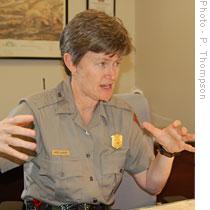 |
| Katie Lawhon |
Katie Lawhon, a spokeswoman for Gettysburg National Military Park, says the new museum and visitor center was built with four goals.
KATIE LAWHON: "One was to take better care of the artifacts and the archives of this park because Gettysburg has the largest publicly owned Civil War collection. We have over one million items, everything from soldiers' diaries and uniforms to original maps of the battlefield and the documentation of the creation17 of the national cemetery in the park.
"The second goal is to take better care of the cyclorama painting. Number three was improve the museum experience for our visitors.
"The fourth and final goal is one that a lot of people find very compelling, which is [that] our facilities were not big enough. They weren't wheelchair-accessible. We had a lot of problems with them. But one of the most serious problems we had with them is they were built on the Union army's battle line. Where we had two buildings and two parking lots there was major battle action and we know over nine hundred seventy soldiers were killed, wounded or captured where we had concrete asphalt and bricks. So this new building is two-thirds of a mile away and it's close to but not on the battle line. And it's going to allow us this fall to take out the old buildings and bring the battlefield back to the way it looked at the time of the fighting."
VOICE TWO:
Visits to the museum begin with a twenty-two minute film called "A New Birth of Freedom." It provides historic18 background for the war, the battle and its effects as a turning point in the Civil War.
The museum has eleven galleries designed around the words of the Gettysburg Address. One gallery is called "Now We Are Met on a Great Battlefield of That War." It explores what happened on each day of the Battle of Gettysburg.
Another gallery, "The Brave Men Living and Dead," presents information about what happened after the fighting ended. It also tells about the effects of the battle on the town of Gettysburg.
The museum also has computers where visitors can research information about the battle.
VOICE ONE:
The new Gettysburg Museum and Visitor Center is a joint19 project of the Gettysburg Foundation and the National Park Service. The foundation, a nonprofit educational group, raised the one hundred seven million dollars that made it possible.
The foundation plans to own the center for twenty years, then donate the building and the land to the federal government.
VOICE TWO:
The president of the foundation, Robert Wilburn, says Gettysburg is a reminder20 that Americans can come together as a nation even after the most divisive of conflicts. He calls it the place where America was saved.
(MUSIC)
VOICE ONE:
Our program was written by Nancy Steinbach and produced by Caty Weaver21. I'm Steve Ember.
VOICE TWO:
And I'm Barbara Klein. Transcripts22 and MP3s of our programs are at voaspecialenglish.com. You can also find programs from THE MAKING OF A NATION, a weekly series all about American history. And join us again next week for THIS IS AMERICA in VOA Special English.
 收听单词发音
收听单词发音 




